STOLEN MOMENTS:
CH 701 Revisited
AFTER TEN YEARS, ZENAIR'S CLASSIC ALL-METAL DESIGN IS STILL GOING STRONG
- By D. "Eddie" Torson
Reprinted from Sport Pilot magazine
There's something to be said
for knowing when to leave well enough alone. After all, when
something works just the way it is, why mess with it?
Of course, there are those in the aviation world to whom the
status quo is anathema. Traditionally, aviation writers have
been among these voices. We like to see new and improved
products, frankly, because it helps generate copy and sell
magazines. It's usually easier to write an article about a
brand-new product than one that's been around for a decade.
| It's not called the STOL for nothing. Takeoff and slow-speed performance is amazing. | 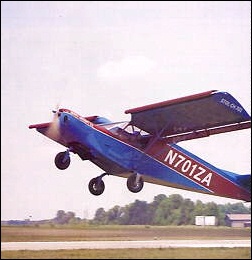 |
We aviation hacks should
be forgiven for rushing to look deeply into every shiny new
bauble on the block. The single most effective word you can
print on the label of a product is "NEW." Consumers
assume that because it's new, it must be better. Sometimes it
is, sometimes it isn't.
But, Madison Avenue aside, when it comes right down to it, if
you want to read a story that's straight from the heart of a
writer, read about an airplane we consider a classic, an
aircraft which appeals to our sense of timelessness,
proportion, and function. To me, the Zenair CH 701 is one of
these aircraft.
| `STOL´ is no exaggeration. Landing distance, it seems, should be measured in inches instead of feet! | 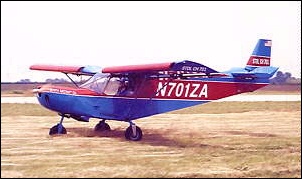 |
For those of you not
familiar with it, the 701 is one of the aircraft created by
prolific designer Chris Heintz. Heintz is a former aerospace
engineer who worked on the Concorde and helped design some of
the most popular light planes in Europe, including several
for Robin in France.
Heintz moved to Canada in 1972 and went to work for de
Havilland. In his heart of hearts, however, he dreamed of
selling aircraft of his own design, so that's just what he
did. In 1974 Heintz showed up at the very first Sun 'n Fun
with his all-metal Zenith CH 200, a low-wing sport plane
years ahead of its time.
Over the years Heintz has designed nearly a dozen more
aircraft, some of which are now out of production and others
which have not yet seen the light at the end of a wind
tunnel. Of all those aircraft, the most visible and
successful has been the diminutive CH 701, a true sport
flying classic.
| For ten years the STOL CH 701 has been a favorite of homebuilders around the globe. Affordable, easy to fly and to build, the STOL 701 is a tough act to top. | 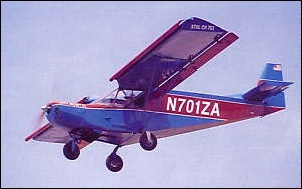 |
The 701 is an unusual
looking airplane, one few would call a natural beauty. Still,
even if its lines are somewhat exaggerated, it possesses the
uncompromising air of the seriously practical machine it is.
The most striking features of the 701 are its full-span
leading edge slats. Though reminiscent of those on the Helio
Courier, the slats on the 701 are different. The units on the
Helio are spring-loaded, to be opened when the air pressure
decreases below a certain level. The idea is to add lift at
slow speeds, where drag isn't really a big factor, and cut
drag at high speed by having the slats retract. Unlike the
Courier, the 701, outfitted with a low-displacement
two-stroke engine, isn't fast enough to benefit from variable
slats, so its slats are fixed, like separate little wines out
in front of the main airfoil. Heintz contends that fixed
slats, instead of the more complicated spring-loaded ones,
reduce building complexity and reduce weight as well as keep
down cost and improve reliability. Besides, the performance
gains of spring loaded slats, if any, would probably be
minimal.
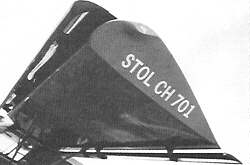 |
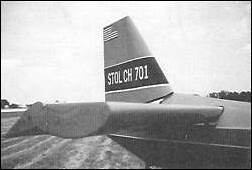 |
| A close-up of the leading edge slats | Unusual is the only word for the 701. The horizontal stab features a convex airfoil and the rudder is an all flying unit |
As you'd
expect, these mini airfoils alter the center of lift of the
airplane, bringing, it forward several inches, even out in
front of the cabin.
The rest of the wing is fairly unusual, too. For starters,
it's only 27 feet in span, though it makes up for it in chord
with an overall wino, area of 122 sq. ft. Gracing the
trailing edge of the 701 wings are full-span flaperons. The
shorter span helps in storage of the aircraft and makes it
less susceptible to wind gusts. Moreover, it's stronger
because it has to support less span.
The other strange looking (once you actually notice it)
component is the tail. Heintz has always liked all flying
tails such as those found on Piper's Cherokees, among other
aircraft. Now the term "flying tail" usually refers
to stabilators, combination elevator/stabilizers which pivot
on a hinge, thereby providing good aerodynamic balance and
easy trimmability. Heintz has taken the concept one step
further, however, by outfitting the 701 with a flying rudder
as well. If you look closely, you'll see that the vertical
tail surface of the airplane is built so that the top part of
the rudder extends well past the natural pivot point. The
effect of the whole arrangement is excellent authority from
surfaces smaller than you'd expect could do the job. Heintz
justifies the unusual design by pointing out that the flying
surfaces help the 701 maintain control response at very low
speeds and with substantial crosswinds.
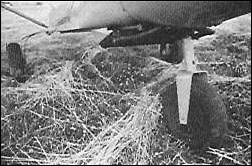 |
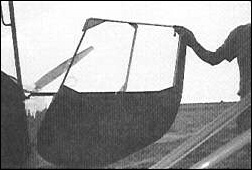 |
| A good view of
the bomb-proof gear. The nose gear is mounted to a bungee suspension chord which is attached directly to the firewall. |
The right stuff
is the light stuff. Here Nicholas Heintz shows off the featherlight door of the 701 |
Constructed
mostly of lightweight aluminum alloy, the CH 701 is an
example of a design on which the pounds are made to count. If
the question is "Where's the beef?" the answer is,
"In all the right places."
The first of those two "right places" is the wing,
spar (one of my favorite components to be overbuilt).
Featuring built-up "I" beam construction, the spar
is completely pre-assembled in the shop. Because of this, the
component can make use of heavy-duty conventional aircraft
rivets. Believe me, it's bombproof.
The envelope, please. The next component to receive the
lifetime achievement award is the landing, gear. The main
gear is a single piece of 3/4 by 4inch stock bent to shape
and fastened to the fuselage substructure with heavy duty
u-bolts. You're not ever going to break this gear. Attached
to this under-carriage are two 1/4-in aluminum wheel yokes
fitted with 16-inch wheels with hydraulic brakes. The nose
gear is nearly as strong, and more cleverly executed than the
mains. Unlike the nose gear on most production aircraft, the
unit on the 701 is essentially a single 2-in, .058-in wall
chrome moly tube attached to a wheel yoke similar to that on
the mains. Suspension is achieved (this is the brilliant
part) though the use of a bungee chord attached both to the
main nose gear leg, and the firewall. The nose gear is not
only cheap to build and easy and cheap to maintain, but it
will take a heck of a lot of punishment and just keep right
on bouncing.
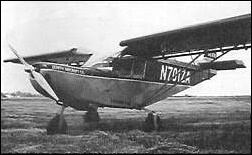 |
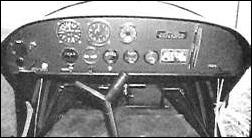 |
| With bold
angles and jutting lines, the 701 has uncompromising
styling. Beefy: With this gear you can get away with a few bounces. |
The panel is all business, though there is room for goodies if the builder so desires. Note the Y-handled stick in the center of the cockpit and the dual throttles near the right and left side walls. |
If it sounds to
you like there's a philosophy of construction at work, here,
you're right. To Chris Heintz, the idea is to make a sturdy,
practical, and easy-to-build components. Consequently, some
of the components on the plane, such as the welded-chromoly
y-handled stick, for example, have a decidedly homemade look
to them. Zenair's components do everything more expensive
stock components would do (except get brittle and crack after
a few years in the sun), but they do it at a quarter of the
cost and with three times the durability. It's more than
philosophy, too. The CH 701 delivers.
Of all the very light aircraft being produced today, perhaps
it's the 701 which borrows most fully from both ultralight
and production aircraft traditions. In its basic shape, the
701 is as conventional as any Cessna on the ramp, with
tractor engine, high wing, tail-in-back, all-metal,
three-axis control configuration.
In performance, however, the 701 is a whole different kind of
airplane, with startlingly short takeoff runs and
hard-to-believe slow-speed capabilities. In a word, it's all
ultralight here.
If the 701 is beefy in all the right places, it's light in
all the other spots. This fact accounts for the plane's
unique feel. The plane weighs just 460 pounds empty, so it's
two-place ultralight legal in US, though the company sells
the vast majority of its planes as Experimentals or Canadian
Advanced Ultralights.
An example of intelligent minimalism: The doors of the plane
are Lexan with light aluminum tubing frames and they, as
everything else on the plane, serve their purpose. They're
durable, easy to build and provide plenty of sunlight.
Though I've photographed it several times, I didn't get a
chance to fly the 701 until a few months back when I visited
the Zenith factory in Mexico, Missouri. There I got the
chance to go flying with Chris' son and Zenith pilot and
Production Manager, Nicholas Heintz.
Inside the cockpit are the two pilot seats, each with good
access to one of two side-mounted throttles and the welded
chromoly stick. The use of the y-handled stick, instead of
two separate ones, is an unusual choice in a light sport
plane. But then again, the 701 is an unusual plane in a
number of other ways, too. Even the throttle is a simple
affair, a piece of steel rod with a "T" welded onto
the end. Functional and impossible to break. Dual rudder
pedals and brakes (optional on the right) are likewise
constructed at the factory out of strong, simple materials,
in this case, chromoly tubing. Besides, crashworthiness and
entry and egress form the aircraft are improved with the
Y-handled stick.
The day of our flight was a
dark, threatening one, and we worked our flight in as soon as
the sky cleared in the morning and before the T-storms
wandered through in the afternoon. We donned headsets (it's
loud without them), fired up the 582, taxied past the row of
typically Midwestern T-hangars next to cornfields and made
our way out to the active runway.
It's fairly tight inside the cabin, though for Nick and me,
both of average size, there was plenty of room. Steering on
the ground is via differential braking 16-in wheels and
hydraulic brakes are standard equipment, and there's nothing,
to it.
Once out at the takeoff end of the long paved runway at
Mexico (total overkill for this airplane), we went through
the plane's simple pre-takeoff check, looked for all the
other traffic that was nowhere in sight and rolled out to go
flying.
Two things about the 701 that became immediately apparent to
me on the takeoff roll were the plane's mind boggling
slow-speed flying capability and the light feel of its
elevator. It was hot and muggy out there that day, but no
more than a couple hundred feet later, we were flying out of
around effect. I was careful, as I always am with an
unfamiliar airplane, not to rotate too aggressively lest the
earth do that smiting thing, it's known for. Even with a
gentle touch, we started climbing briskly right off the bat,
and I relaxed a little of the slight back-pressure I was
holding.
With two aboard, full fuel, and high levels of mercury in the
thermometers (high 90s, with humidity to match), I didn't
expect any earth shattering climb performance from the 701
and I was right. It did climb out very solidly though, at 500
or 600 fpm, which is a lot better than any Cessna 152 would
have done that day on a lot more horsepower.
In retrospect, if I were to operate a 701 regularly under
demanding conditions, I think the two-stroke Rotax 618 with
its ten more horses would be a natural for this airplane. The
four-stroke 912, on the other hand, would transform the 701
into a much quieter, even better-performing airplane than it
already is. Still, the engine I was flying was a 582, and it
was no slouch.
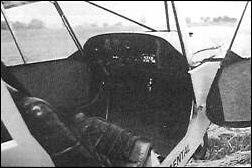 |
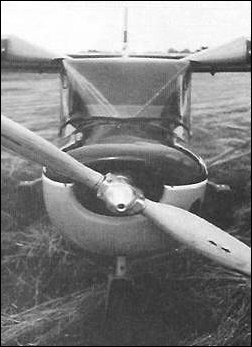 |
| The STOL CH 701 features wide doors on both sides and plenty of interior room. | The factory demonstrator 701 which I flew is outfitted with the Rotax 582, though both the 912 and 503 are good alternatives depending on your applications. |
Up in the air,
Nick watched as I did the usual routine, slow flight, stalls,
both power-on and power-off, steep turns, dutch rolls and the
like. The airplane can fly at a crawl. Waiting for the stall
to arrive is like waiting for the end of your first opera;
you think it's never going to come!
The CH 701 STOL handles more like an ultralight than a
production aircraft, with a high degree of built-in drag -
flaperons, and leading, edge slats and don't forget - the
associated adverse yaw.
So if you're looking for a really fast airplane, the 701
ain't it. Though lots of people fly the plane cross-country,
if that's your thing, I'd recommend the company's CH 601
Zodiac. With the 701, the same things that make it fly so
slowly conspire against it in the speed department. It's no
slower than most aircraft in its class (the company claims a
cruise of 75), but it will fly a good deal more slowly. In my
book, that's a net gain.
By the time I got done with the routine at the practice area,
the bottoms of the clouds were no more than 800 or 900 feet
off the deck, and they were doing nothing but getting lower.
Rain was imminent. If we went right back to the field, we'd
have time for a few more touch and goes, so I turned the
plane north and headed back to Mexico.
Where the aerodynamics of the plane come in to play are at
the low end of the scale. It's here that the 701 shines, as I
found out when we shot a couple of landings and later when
Nick made some slow-speed fly-bys off the grass strip while I
photographed the plane from the ground. Like many planes in
its class, the 701 comes in nicely and predictably with a
little power. Full stall landings will give you remarkably
short landing performance, but make sure you hit the flare
right on. Then again, if you're a foot or two too high, the
gear will probably take it.
Though it wasn't on the airplane I flew back in Mexico, a new
all-terrain gear is now standard on the CH-70 1. The gear is
similar in design to that of the older gear, but utilizes a
direct attachment of the wheel to the main gear spring and
the use of 8.00 by 6-inch wheels and 16-inch tundra tires.
The nose gear maintains its bungee-suspension design while
adding the same hefty wheel/tire combination as the mains.
Independent hydraulic disk brakes are also now standard on
the airplane.
When you think about it, the landing gear of the 701 must
sell a lot of planes for the company. Whereas taildraggers
can be hard to handle in a crosswind, or just plain hard to
handle for some pilots, the tricycle gear of the 701 is
nearly foolproof. And because it's set so wide, you'd be hard
pressed to make anything but decent landings.
Back to the simple component philosophy. The use of
uncomplicated, factory-built components results not only in a
strong, durable piece of equipment, but an inexpensive one,
as well. The cost of the kit - minus engine, instruments and
finish coat - is just $11,670. If you've checked kit sticker
prices lately, you know that the CH 701's price tag is a
couple thousand dollars less than most planes in its' class.
Its low cost has evidently attracted lots of customers. The
company reports that more than 350 CH 701s have been
successfully built and flown. A good number of those fly in
the summertime on Zenair's very pretty amphibious floats.
Zenair recommends the Rotax 912 for floatplane use, though
the 582 worked fine for floats for years before the 912 came
out.
Doubtless, the reason for the kit's success can be summed up
in a word, value. With the 701, you get a good flying
airplane at a great price. What more could you ask for?
